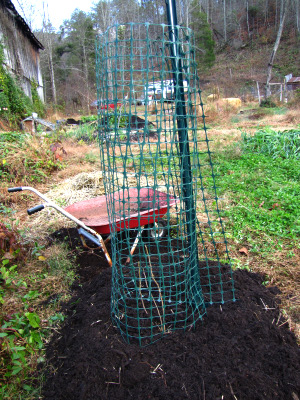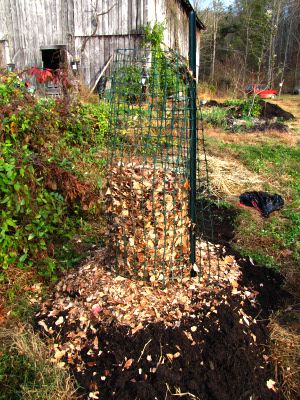
Chicago hardy fig
 Our Chicago Hardy Fig arrived
on the same day as our Carpathian walnuts even though it was coming
from a different nursery --- clearly, this must be prime fall-planting
time in zone 6. Like rosemary, planting figs outdoors is a
dicey proposition in our region, but I'm hopeful that careful variety
selection and winter protection will let us harvest our own fruits in a
few years.
Our Chicago Hardy Fig arrived
on the same day as our Carpathian walnuts even though it was coming
from a different nursery --- clearly, this must be prime fall-planting
time in zone 6. Like rosemary, planting figs outdoors is a
dicey proposition in our region, but I'm hopeful that careful variety
selection and winter protection will let us harvest our own fruits in a
few years.
If various fig-growers
on the internet are to be believed, the hardiest fig varieties are
Chicago Hardy, Mission, Brown Turkey, Alma, Nordland, and
Celeste. Chicago Hardy won my admiration since it's reputed to be
able to produce fruit on new wood even if the top dies back to the
ground, which means that as long as the roots don't die, we will get
some sort of crop from our fig every year. In contrast, if you're
growing another variety of fig, you will have to wait until the next
year (and risk being winter-killed again) before tasting fruits from
your fig after a cold winter.
 Despite the promise of cold
hardiness, I went ahead and protected my fig, staking a loop of trellis
fencing around it and then filling the loop up with leaves. In
coldier climates (zone 5), fig growers go to more extremes, sometimes
carefully bending the plant over and burying it in a trench of
soil. Other growers simply convert their fig to a potted plant
and bring it in for the winter.
Despite the promise of cold
hardiness, I went ahead and protected my fig, staking a loop of trellis
fencing around it and then filling the loop up with leaves. In
coldier climates (zone 5), fig growers go to more extremes, sometimes
carefully bending the plant over and burying it in a trench of
soil. Other growers simply convert their fig to a potted plant
and bring it in for the winter.
As a final note, growers
of Chicago Hardy do have one warning I plan to take to heart.
This particular variety of fig fruits much less if unpruned, so be sure
to cut stems back to 30 inches every year and clear out all but three
main branches. If all goes as planned, we could be tasting our
first homegrown fig as early as 2012.
Want more in-depth information? Browse through our books.
Or explore more posts by date or by subject.
About us: Anna Hess and Mark Hamilton spent over a decade living self-sufficiently in the mountains of Virginia before moving north to start over from scratch in the foothills of Ohio. They've experimented with permaculture, no-till gardening, trailersteading, home-based microbusinesses and much more, writing about their adventures in both blogs and books.
Want to be notified when new comments are posted on this page? Click on the RSS button after you add a comment to subscribe to the comment feed, or simply check the box beside "email replies to me" while writing your comment.

I'm so glad you posted this!
I had despaired of finding figs that would grow here in Zone 5A near Chicago! All of the tree descriptions I'd seen listed them as being hardy only to Zone 6. With the options of overwintering them in mulch or potting them and bringing them indoors, I may have to try Hardy Chicago, Celeste and English Brown Turkey (via Edible Landscaping in VA)next year and see how they do.
Best wishes with your young figs!
Hi Anna,
My hubby found your link, and I just ordered your poultry waterer kit (thanks!)
I'm curious about the pruning back to 3 stems advice:
- Where did you read/hear this, and - what was the reasoning given for it?
- You also didn't mention the time of year you cut back the stems.
I've had my fig for almost 5 years, and only this past year did I move it to a less sheltered spot, but where it gets more sun. In past years it didn't form fruits early enough for them to ripen before first frosts, but this year I'm hoping we'll be able to eat them. So far we've gotten a couple of handfuls of figs - and they were well worth the effort and wait!
Thanks for trying out our chicken waterers!
To answer your questions, I'm pretty sure I read lots of forums to get that pruning advice. I can't point you to any specific one, but the advice was repeated multiple times by seemingly knowledgeable growers, so I thought I'd try it out.
I think I'll prune to three stems when I uncover the fig in the spring since we have cold winters. That way, I can choose three stems that didn't get damaged by freezes. I might cut the whole plant back to 30 inches in the fall, though, to make it easier to protect.
Also, the one thing I do remember is that this pruning advice was specific for the Chicago Hardy Fig. So, if your fig is another variety, that might not be the thing to do!
Our tree looks beautiful right now, but no figs for us this year. (It started tiny, though.) Next year, I'll bet!
In general, if you know how to prune a fruit tree, you'll get larger, higher quality fruits, although not necessarily more of them. I'll definitely be pruning my fig in the spring once I'm sure which branches survived the winter.
Hi. I just wanted to let you know that we've been successfully growing Brown Turkey figs in a suburbs of Buffalo NY for 30 years or so. Here in zone 5, we've got to bury the trees each fall. We dig around the roots several feet deep, and then a long trench off to one side. We then lean the tree over (usually tying it with rope to contain the multiple trunks... they resemble shrubs here), throw in leaves and mulch, put some old boards on to protect the trunks/stems/branches, and then cover the whole thing over with several feet of soil. Exhuming them in the spring takes a bit of care to avoid breaking them. The whole thing is pretty labor intensive, but we've gotten tons of fresh figs, in a continuous crop starting in late summer (ripening on the tree). Trees grow to about 6 - 7 feet, very shrub-like with lots of stems. We've never pruned this variety back to three stems... the only pruning we do is to remove the dead branches and stems that don't survive the winter. One other tip: don't place them anywhere near a Black Walnut tree... when we put in a black walnut tree within about 100', those trees stopped producing fruit (some compound that's released in the soil, "jacalone" or something like that, which inhibits fig production and possibly tomatoes as well). (Also, I have no idea what distance from a walnut tree is "safe", but 100' is not enough).
We've also tried potting them over the winter and bringing indoors, but haven't had as much luck getting figs that way. The trees survived but didn't produce fruit. Last year I put a couple of them in 2.5' pots and let them go dormant in the garage... I don't know if we'll get fruit from those trees this year (2012) or not, but they survived (and are budding out in the unusually warm winter/spring here now). If I remember I'll post back here next fall to let you know if I get any fruit from them.
Lastly, I'm about to try some Chicago Hardy varieties... am just ordering them now. If it's true that I can avoid all this burying / unburying, that'd be a huge improvement! I may just pile hay and mulch around them within some sort of containment for some bit of protection anyway (that technique didn't work with the Brown Turkey variety here though... I lost those trees to the freeze). I'm hopeful it'll work.
It's a long post... but I wanted to let you know that figs can be grown in zone 5 successfully, albeit with quite a bit of labor. Hopefully Chicago Hardy will reduce the amount of work.
Mike
Will do! And sorry for the typos in that post.
I forgot to add that each Chicago Hardy is expected, when mature, to produce 70-80 figs. I believe that puts me on track to have upwards of 800 to 900 figs each year. I may not have thought this out well enough in advance, especially as I'm the only one in the house who likes them.
No need to apologize about typos. I make them too.
Interesting data on the number of figs per mature plant. You can always dry the excess --- that's my favorite way to eat figs. Three dried figs per day doesn't sound like much at all....
You can NEVER have too many figs I had a chicago hardy and made jelly, everyone absolutely loved it!